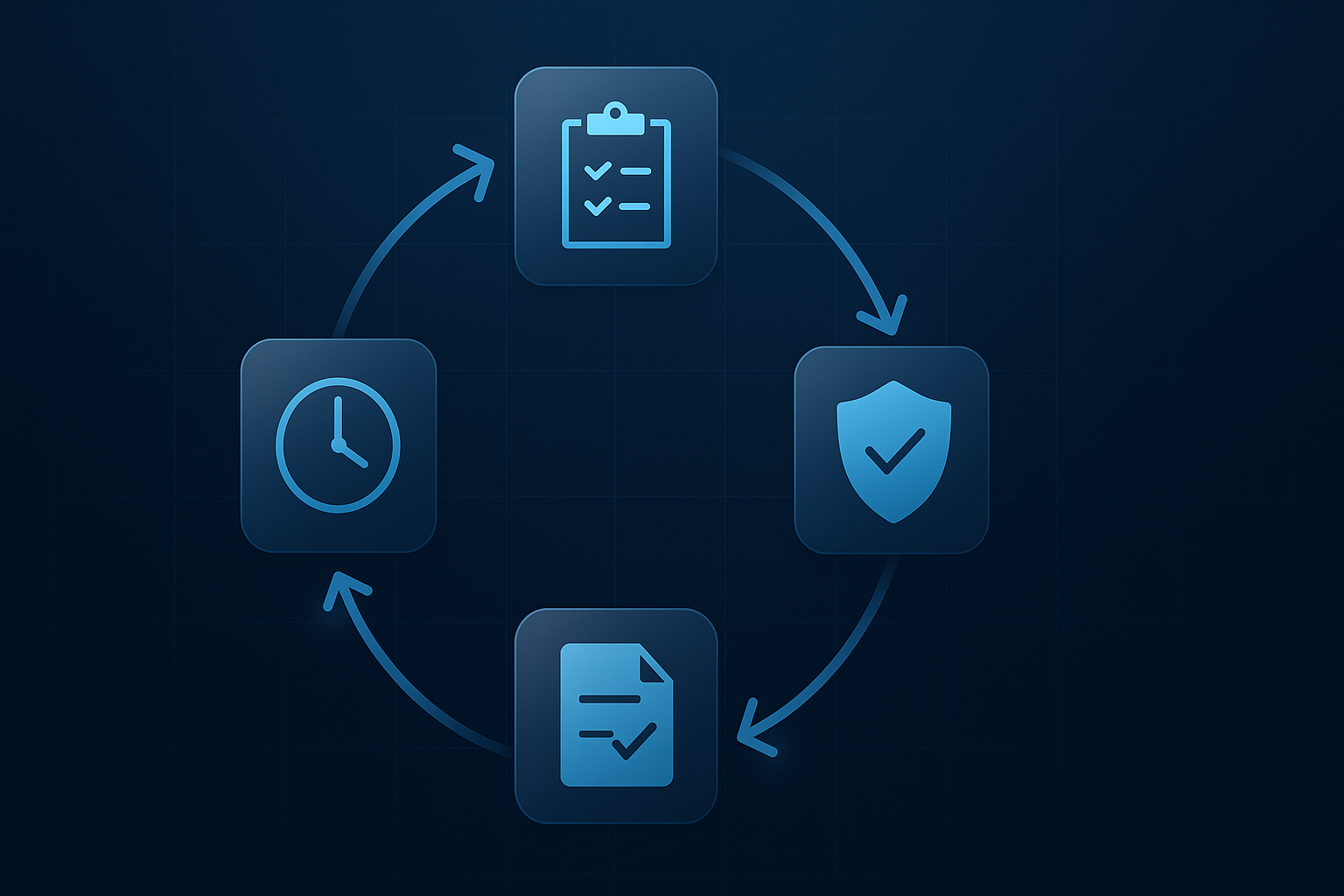Active After-Action Reporting: The Missing Link Between Incident Response and Business Continuity Testing
Most organizations “do” After-Action Reports (AARs). Few turn them into momentum. The typical cycle—run a tabletop or manage an incident, write a PDF, file it away—creates shelfware, not resilience. The alternative is active AAR: a continuous, instrumented loop that captures what happened, turns insights into owned actions, updates playbooks, and validates fixes through retests. Done right, active AAR bridges the gap between incident response and business continuity testing, converting every event—exercise or real—into measurable readiness.
What an AAR is (and what “active” adds)
An AAR documents what occurred, what worked, what didn’t, and what to improve. Traditional AARs emphasize review and documentation. Active AARs extend this to execution and verification. They treat the report as a live workflow: findings are turned into assigned actions with deadlines, playbooks change in response to those actions, and retests confirm the change actually works. In other words, the AAR becomes the gear that turns the program, not the scrapbook that remembers it.
Key contrasts:
- Static vs. dynamic: From a one-time write-up to a living backlog that moves through to closure.
- Opinion vs. evidence: From anecdotes to structured data (timelines, owners, artifacts, timestamps).
- Isolated vs. integrated: From siloed documents to a loop spanning incident response, continuity, crisis comms, and audit.
Where active AAR fits in your program
Incident response frameworks place “post-incident activity” as a formal phase. Business continuity standards emphasize continual improvement. Active AARs knit these together by ensuring the same lessons inform both security operations and continuity testing:
- During incidents: capture timeline, decisions, control behaviors, impacts, and workarounds.
- During exercises: stress-test plans under controlled conditions, identify gaps, and pre-assign owners for remediation.
- Between events: update playbooks and run targeted retests (mini-exercises, simulations, or drills) to confirm gaps are closed.
With this integration, continuity doesn’t drift away from real operational experience, and incident response benefits from BC’s structured testing cadence.
The Active AAR Loop
Think of active AAR as a closed loop that runs the same way for a real incident or an exercise:
- Capture
Gather facts while they’re fresh. Use time-stamped entries, chats, ticket excerpts, system alerts, and decision points. A simple structure—what happened, why it mattered, who did what, and with what effect—ensures consistent data. Avoid blank pages by guiding capture with prompts and predefined fields. - Analyze
Distill signal from noise: Where did detection lag? Which control failed? Was escalation late? Did communications create confusion? Tag each insight to a category (detection, containment, recovery, comms, third parties, facilities, etc.) so patterns emerge over time. - Assign & Prioritize
Convert findings into Improvement Plan items with clear owners, due dates, and acceptance criteria. Prioritize by risk reduction and recurrence likelihood. Link each action to the affected runbook or continuity plan section to ensure it changes the operational reality. - Update Playbooks & Plans
The most critical step—and the most often skipped. Apply diffs to IR playbooks, communication templates, BC recovery procedures, call trees, vendor runbooks, and facility protocols. Track the delta (what changed, where, and why) to create traceability for audits. - Validate (Retest)
Don’t trust—test. Schedule a quick retest focused on the changed steps: a targeted tabletop, a technical drill, or a comms rehearsal. Mark actions “done” only after the retest passes and evidence is attached. - Evidence & Reporting
Package outcomes: updated plan excerpts, screenshots, tickets, and retest results. This creates an audit-ready trail showing that the organization learns and improves, not just documents.
KPI pack: measure improvement, not paperwork
Active AARs shine when they change metrics that matter. Build a small, visible dashboard:
- Closure rate & time-to-close for AAR actions
- Retest pass rate (first pass vs. second pass)
- Mean Time to Detect/Respond/Recover deltas (pre- vs. post-improvement)
- Recurrence rate of similar incidents or exercise findings
- Playbook delta count (how many procedures were improved)
- Ownership distribution (to avoid overloading a single team)
Share these monthly or quarterly. Executives don’t need the blow-by-blow—they need to see trend lines proving resilience is compounding.
Governance and cadence
A single heroic AAR won’t change your risk profile; consistent cadence will. Establish:
- A standard AAR template for incidents and exercises (same fields, same flow).
- A monthly review board (IR + BC + key business owners) to unblock actions and re-prioritize.
- Quarterly thematic analysis across AARs (e.g., “comms bottlenecks,” “handoff issues,” “cloud runbook gaps”).
- Planned retests tied to action due dates. If a fix can’t be verified, it isn’t finished.
- Executive roll-ups that frame AAR outputs in business terms: reduced downtime, lower vendor risk, faster customer comms.
30-minute AAR recipe (that teams will actually do)
Keep it light, consistent, and respectful of cognitive load:
- Prep (5 min): Auto-compile timeline artifacts (alerts, tickets, major comms) and pre-populate the AAR.
- Round-robin facts (10 min): What happened? What helped? What hurt? Keep it blameless and concrete.
- Top-3 improvements (10 min): Decide the three highest-impact actions; assign owners and acceptance tests.
- Retest plan (3 min): Define how you’ll validate the changes, by when, and with whom.
- Close (2 min): Confirm updates to affected playbooks and who will file evidence.
This tight format prevents “AAR fatigue” while still producing data you can aggregate.
Common failure modes—and how active AARs prevent them
- Failure to assign: Findings without owners die. Fix: assign in-meeting with due dates and acceptance criteria.
- Fixes that don’t change reality: Edits sit in a doc while responders follow old habits. Fix: link actions directly to playbook steps and workflows.
- No proof of improvement: “We fixed it, trust us.” Fix: require retest evidence before closure.
- Over-indexing on tech: Many gaps are process or comms. Fix: tag findings by category and track distribution.
- Shelfware reports: PDFs vanish. Fix: keep the AAR as a living board with status, not a static artifact.
How Opsbook powers active AAR
Active AARs are a methodology; Opsbook makes them operational:
- Automated capture: Pull timelines from exercises or real incidents so no one starts with a blank page.
- Guided, blameless AARs: Structured prompts keep discussions factual and repeatable across teams.
- Improvement Plans with ownership: Turn findings into tasks with owners, due dates, and acceptance tests—visible in one board.
- One-click playbook updates: Apply diffs to incident response runbooks and continuity procedures so fixes persist where people work.
- Retest scheduling & evidence: Plan mini-exercises or drills, attach evidence, and lock closure behind a passed retest.
- Audit-ready exports: Generate AAR/IP packages showing what changed, why it changed, who signed off, and the results.
With Opsbook, the story of an event doesn’t end at documentation; it ends at validated improvement.
Getting started
- Pick one template for both incidents and exercises.
- Instrument capture (timelines, decisions, artifacts) so data flows in automatically.
- Define acceptance criteria for actions up front.
- Tie every action to a playbook step. If nothing changed, ask why.
- Schedule a retest on the spot—and don’t mark “done” until it passes.
- Publish a simple dashboard so leaders see progress across quarters.
Bottom line: Active AAR closes the loop between incident response and business continuity testing. It replaces “write, file, forget” with “capture, improve, verify.” Teams learn faster, audits get easier, and resilience becomes a measurable asset—not a hopeful aspiration.
See how Opsbook turns every incident and exercise into improvement.






